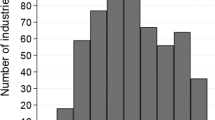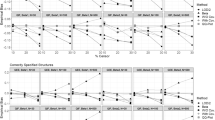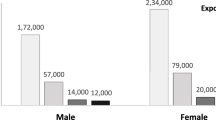Abstract
The epidemiologic evidence for the carcinogenicity of lead is inconsistent and requires improved exposure assessment to estimate risk. We evaluated historical occupational lead exposure for a population-based cohort of women (n=74,942) by calibrating a job-exposure matrix (JEM) with lead fume (n=20,084) and lead dust (n=5383) measurements collected over four decades in Shanghai, China. Using mixed-effect models, we calibrated intensity JEM ratings to the measurements using fixed-effects terms for year and JEM rating. We developed job/industry-specific estimates from the random-effects terms for job and industry. The model estimates were applied to subjects’ jobs when the JEM probability rating was high for either job or industry; remaining jobs were considered unexposed. The models predicted that exposure increased monotonically with JEM intensity rating and decreased 20–50-fold over time. The cumulative calibrated JEM estimates and job/industry-specific estimates were highly correlated (Pearson correlation=0.79–0.84). Overall, 5% of the person-years and 8% of the women were exposed to lead fume; 2% of the person-years and 4% of the women were exposed to lead dust. The most common lead-exposed jobs were manufacturing electronic equipment. These historical lead estimates should enhance our ability to detect associations between lead exposure and cancer risk in the future epidemiologic analyses.
This is a preview of subscription content, access via your institution
Access options
Subscribe to this journal
Receive 6 print issues and online access
$259.00 per year
only $43.17 per issue
Buy this article
- Purchase on Springer Link
- Instant access to full article PDF
Prices may be subject to local taxes which are calculated during checkout



Similar content being viewed by others
References
NRC. Lead in the Human Environment. Committee on Lead in Human Environment, National Research Council, National Academy of Science: Washington, DC, 1980.
ATSDR. Toxicological profile for lead. Agency for Toxic Substances and Disease Registry, US Department of Health and Human Services, Public Health Service: Atlanta, 2007.
Park DU, Paik NW . Effect on blood lead of airborne lead particles charaterized by size. Ann Occup Hyg 2002; 46: 237–243.
Hodgkins DG, Robins TG, Hinkamp DL, Schork MA, Levine SP, Krebs WH . The effect of airborne lead particle size on worker blood-lead levels: an empirical study on battery workers. J Occup Med 1991, 1265–1273.
Moline JM, Landrigan PJ . Lead. In: Rosenstock L, Cullen MR, Brodkin CA, Redlich CA, (eds). Textbook of Clinical Occupational and Environmental Medicine, 2nd edn. Elsevier Saunders, Philadelphia, 2005 pp 967–978.
IARC. Inorganic and organic lead compounds. IARC monographs on the evaluation of carcinogenic risks to humans, vol. International Agency for Research on Cancer 2006; 87: 228–237.
Fu H, Boffetta P . Cancer and occupational exposure to organic lead compounds: a meta-analysis of published data. Occup Environ Med 1995; 52: 73–81.
Jemal A, Graubard BI, Devesa SS, Flegal KM . The association of blood lead level and cancer mortality among whites in the United States. Environ Health Perspect 2002; 110: 325–329.
Steenland K, Boffetta P . Lead and cancer in humans: where are we now? Am J Ind Med 2000; 38: 295–299.
Bhatti P, Stewart PA, Hutchinson A, Rothman N, Linet MS, Inskip PD et al. Lead exposure, polymorphisms in genes related to oxidative stress, and risk of adult brain tumors. Cancer Epidemiol Biomarker Prev 2009; 18: 1841–1848.
Boffetta P, Fontana L, Stewart P, Zaridze D, Szeszenia-Dabrowska N, Jaar B et al. Occupational exposure to arsenic, cadmium, chromium, lead and nickel, and renal cell carcinoma: a case-control study from Central and Eastern Europe. Occup Environ Med 2011; 68: 723–728.
Cocco P, Ward MH, Dosemeci M . Occupational risk factors for cancer of the gastric cardia. Analysis of death certificates from 24 US states. J Occup Environ Med 1998; 40: 855–861.
Golabek T, Darewicz B, Borawska M, Markiewicz R, Socha K, Kudelski J . Lead concentration in the bladder tissue and blood of patients with bladder cancer. Scand J Urol Nephrol 2009; 43 (6): 467–470.
Rajaraman P, Stewart PA, Samet JM, Schwartz BS, Linet MS, Zahm SH et al. Lead, genetic susceptibility, and risk of adult brain tumors. Cancer Epidemiol Biomarkers Prev 2006; 15: 2514–2520.
Rousseau MC, Parent ME, Nadon L, Latreille B, Siemiatycki J . Occupational exposure to lead compounds and risk of cancer among men: a population-based case-control study. Am J Epidemiol 2007; 166: 1005–1014.
van Bemmel DM, Boffetta P, Liao LM, Berndt SI, Menashe I, Yeager M et al. Comprehensive analysis of 5-aminolevulinic acid dehydrogenase (alad) variants and renal cell carcinoma risk among individuals exposed to lead. PLoS One 2011; 6: e20432.
van Wijngaarden E, Dosemeci M . Brain cancer mortality and potential occupational exposure to lead: findings from the National Longitudinal Mortality Study, 1979–1989. Int J Epidemiol 2006; 119: 36–44.
Zheng W, Chow W-H, Yang G, Jin F, Rothman N, Blair A et al. The Shanghai Women’s Health Study: rationale, study design, and baseline characteristics. Am J Epidemiol 2005; 162: 1123–1131.
Friesen MC, Coble JB, Lu W, Shu X-O, Ji B-T, Xue S et al. Combining a job exposure matrix with exposure measurements using an empirical Bayes framework to assess occupational exposure to benzene in a population cohort in Shanghai, China. Ann Occup Hyg 2012; 56: 80–91.
Gu XQ . Experience in controlling lead poisoning in the People’s Republic of China. Scand J Work Environ Health 1985; 11 (suppl 4): 16–19.
Wang YL . Industrial lead poisoning in China over the past 33 years. Ecotox Environ Safe 1984; 8: 526–530.
Ye X, Wong O . Lead exposure, lead poisoning, and lead regulatory standards in China, 1990–2005. Regul Toxicol Pharm 2006; 46: 157–162.
Lubin JH, Colt JS, Camann D, Davis S, Cerhan JR, Severson RK et al. Epidemiological evaluation of measurement data in the presence of detection limits. Environ Health Perspect 2004; 112: 1691–1696.
Robinson GK . That BLUP is a good thing: the estimation of random effects. Stat Sci 1991; 6: 15–51.
Casella G . An introduction to empirical Bayes data analysis. Am Stat 1985; 39: 83–87.
Kromhout H, Vermeulen R . Application of job-exposure matrices in studies of the general population: some clues to their performance. Eur Respir Rev 2001; 11: 80–90.
Rappaport SM . Assessment of long-term exposures to toxic substances in air. Ann Occup Hyg 1991; 35: 61–121.
Christiani DC . Occupational health in the People’s Republic of China. Am J Public Health 1984; 74: 58–64.
Tang HW, Liang YX, Hu XH, Yang HG . Alterations of monoamine metabolites and neurobehavioral function in lead-exposed workers. Biomed Envrion Science 1995; 8: 23–29.
Wang YL, Lu PK, Chen ZQ, Liang YX, Lu QM, Pan ZQ et al. Effects of occupational lead exposure. Scand J Work Environ Health 1985; 11 (suppl 4): 20–25.
Gustavsson P, Plato N, Hallqvist J, Hogstedt C, Lewne M, Reuterwall C et al. A population-based case-referent study of myocardial infarction and occupational exposure to motor exhaust, other combustion products, organic solvents, lead, and dynamite. Epidemiol 2001, 222–228.
Henn SA, Sussell AL, Li J, Shire JD, Alarcon WA, Tak S . Characterization of lead in US workplaces with data from OSHA’s Integrated Management Information System. Am J Ind Med 2011, 356–365.
Fischbein A, Hu H . Occupational and environmental exposure to lead. In: Rom WN, (ed). Environmental and Occupational Medicine, 4th edn. Lippincott Williams & Wilkins, Philadelphia, 2007 pp 955–990.
ILO. Women in labour markets: measuring progress and identifying challenges. Geneva, 2010.
Kennedy SM, Koehoorn M . Exposure assessment in epidemiology: dose gender matter? Am J Ind Med 2003; 44: 576–583.
Froines JR, Liu WCV, Hinds WC, Wegman DH . Effects of aerosol size on the blood lead distribution of industrial workers. Am J Ind Med 1986; 9: 227–237.
Tsai CJ, Shih TS, Sheu RN . Characteristics of lead aerosols in different work environments. Am Ind Hyg Assoc J 1997; 58: 650–656.
Vlaanderen J, Fransman W, Miller B, Burnstyn I, Heederik D, Hurley F et al. A graphical tool to evaluate temporal coverage of occupational history by exposure measurements. Occup Environ Med 2010; 67: 636–638.
Acknowledgements
This research was supported by the US National Institutes of Health (grant R37 CA70867) and the Intramural Research Program of the National Institutes of Health (contract N02 CP1101066).
Author information
Authors and Affiliations
Corresponding author
Ethics declarations
Competing interests
The authors declare no conflict of interest.
Additional information
Supplementary Information accompanies the paper on the Journal of Exposure Science and Environmental Epidemiology website
Supplementary information
Rights and permissions
About this article
Cite this article
Koh, DH., Bhatti, P., Coble, J. et al. Calibrating a population-based job-exposure matrix using inspection measurements to estimate historical occupational exposure to lead for a population-based cohort in Shanghai, China. J Expo Sci Environ Epidemiol 24, 9–16 (2014). https://doi.org/10.1038/jes.2012.86
Received:
Revised:
Accepted:
Published:
Issue Date:
DOI: https://doi.org/10.1038/jes.2012.86
Keywords
This article is cited by
-
Development of a source-exposure matrix for occupational exposure assessment of electromagnetic fields in the INTEROCC study
Journal of Exposure Science & Environmental Epidemiology (2017)
-
New Opportunities in Exposure Assessment of Occupational Epidemiology: Use of Measurements to Aid Exposure Reconstruction in Population-Based Studies
Current Environmental Health Reports (2017)
-
A review of toxicity and mechanisms of individual and mixtures of heavy metals in the environment
Environmental Science and Pollution Research (2016)
-
Reliability and validity of expert assessment based on airborne and urinary measures of nickel and chromium exposure in the electroplating industry
Journal of Exposure Science & Environmental Epidemiology (2014)



